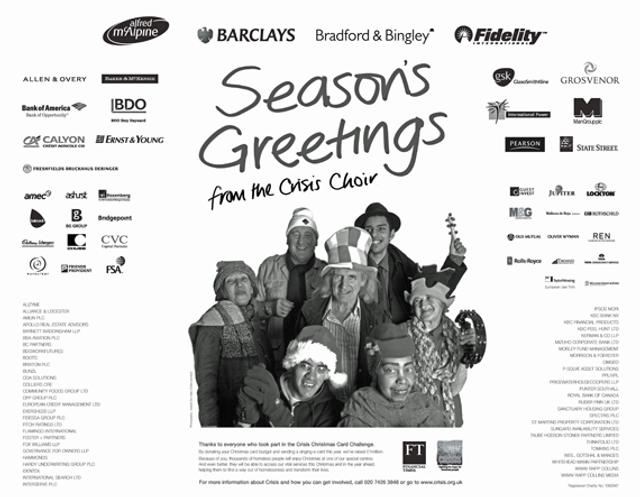Crisis Christmas card challenge
- Exhibited by
- Melissa Gibbons – corporate partnerships executive.
- Added
- August 31, 2009
- Medium of Communication
- Face to face, online, press advertising.
- Target Audience
- Single gift, corporations.
- Type of Charity
- Poverty/social justice.
- Country of Origin
- UK.
- Date of first appearance
- 2007.
SOFII’s view
Sometimes corporate fundraising initiatives really do work. ‘Send a singer’ is one such example from a charity for homeless people in the UK – it’s fun, it’s engaging, it’s compatible with the charity’s values, is a delightful way of promoting the cause and it raises big money rather consistently. Terrific!
Creator / originator
WWAV Rapp Collins Limited, London – a direct marketing agency
Summary / objectives
Crisis is a national charity that fights homelessness and empowers people to fulfil their potential and transform their lives.
The Christmas card challenge (CCC) is the annual corporate fundraising Christmas campaign run by Crisis in partnership with the Financial Times newspaper (FT).
The campaign asks companies to donate their Christmas card budget to Crisis instead of sending Christmas cards. In return for their donation, each company’s Christmas greetings are communicated via a double-page spread advert in the Financial Times UK and worldwide editions reaching a global audience of over 1.5 million.
The challenge for 2007 was to refresh and revitalise a campaign entering its twelfth year.
Background
The campaign:
The concept developed for the 2007 Christmas card challenge was ‘Send a Singer’. This concept permeated the entire campaign and shaped the marketing and PR materials produced, as well as forming the central theme of both the e-card and double-page spread FT advert. The ‘Send a Singer’ concept not only provided a creative focus but also effectively integrated the client group into the campaign. Each singer featured in the e-cards and throughout the entire campaign was a homeless member of the learning and activity centre, Crisis Skylight.
Corporate involvement:
Companies could choose to become involved at three different levels in return for a donation of £3000, £15,000, or £25,000.
Campaign micro-site:
The site www.sendasinger.com was at the centre of the 2007 campaign, becoming the principal destination to which all marketing and recruitment activity was driven.
Thanking donors:
After Christmas all participants received a report on the Crisis Open Christmas project highlighting the impact of their funding.
Special characteristics
- Placing homeless people at the heart of the campaign. This brought the donors in direct contact with the cause.
- Concentrating on digital marketing brought the concept of the choir of homeless singers to life in an immediate way, which no other medium would have allowed.
- The digitally integrated fundraising approach is new in the charity sector where user engagement is relatively easy to achieve, but conversion into donors is notoriously difficult. This campaign delivered both
Results
The campaign worked really well.
Merits
In essence the campaign addresses corporate social responsibility agendas, offers a practical solution to the traditional Christmas card chore and offers participating companies a unique and high impact marketing opportunity. The unique and very immediate involvement of homeless people genuinely helped to engage donors with the cause, challenged perceptions and conveyed Crisis’s aim to empower homeless people to fulfil their potential and transform their lives.
 View original image
View original image
 View original image
View original image

















